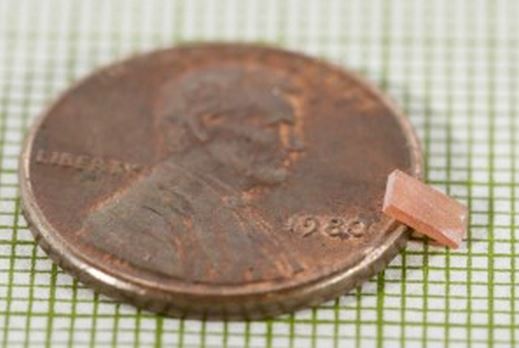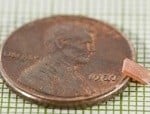Frustrated magnets are so called because they ought to be magnetic at low temperatures but aren’t. Scientists at Princeton University carried out an experiment that revealed unlikely behavior in frustrated magnets, which they believe addresses a long-debated question about the nature of these discontented quantum materials.
N. Phuan Ong, Princeton’s Eugene Higgins Professor of Physics, and colleagues believe their finding represents a surprising discovery that may eventually offer new research directions for advanced electronics.
Their study, which has been published in the academic journal Science (citation below), may also help explain the mechanism of high-temperature superconductivity, the frictionless transmission of electricity.

A crystal of frustrated magnet (Tb2Ti2O7). (Image Credit: Jason Krizan)
Testing for the Hall Effect
The scientists tested the frustrated magnets to see whether they exhibited a behavior called the Hall Effect.
When a magnetic field is applied to an electric current that flows in a conductor, such as a copper ribbon, the current deflects to one side of the ribbon. American physicist Edwin Herbert Hall (1855–1938) first observed this deflection in 1879. It is currently used in sensors for devices such as computer printers and vehicle anti-lock braking systems.
Given that the Hall Effect happens in charge-carrying particles, the majority of scientists believed it would not be possible to see such behavior in neutral (non-charged) particles like those in frustrated magnets.
Prof. Ong said:
“To talk about the Hall Effect for neutral particles is an oxymoron, a crazy idea.”
However, some theoretical physicists speculated that neutral particles in frustrated magnets might bend to the Hall rule in a near absolute-zero environment (super cold), where particles behave according to the laws of quantum mechanics instead of the classical physical laws we see in the world around us.
Harnessing quantum behavior could lead to some spectacular innovations in electronic devices and computing.
Does Hall Effect exist in frustrated magnets?
Prof. Ong and Chemistry Professor Robert Cava, as well as their graduate students Jason Krizan and Max Hirschberger, set out to determine whether they could settle the debate and demonstrate compellingly that the Hall Effect exists for frustrated magnets.
To do this, the scientists turned to pyrochlores, a class of magnets that contain magnetic moments, that at extremely low temperatures near absolute zero, should line up in an orderly manner so that all their ‘spins’ (a quantum-mechanical property) point in the same direction.
Researchers have found that the spins point in random directions. These frustrated materials are also called ‘quantum spin ice’.
Prof. Ong said:
“These materials are very interesting because theorists think the tendency for spins to align is still there, but, due to a concept called geometric frustration, the spins are entangled but not ordered.”
Entanglement is an important property of quantum system that scientists hope to exploit for building a quantum computer, which could solve problems that current computers are unable to handle.
While chatting in a hallway, Prof. Ong discovered that Cava had the know-how and experimental infrastructure to make such materials. He tasked Krizan, a chemistry graduate student, with growing the crystals, while physics graduate student Hirschberger set up the experiments required to look for the Hall Effect.
Hirschberger said:
“The main challenge was how to measure the Hall Effect at an extremely low temperature where the quantum nature of these materials comes out.”
The experiments were carried out at temperatures of 0.5 degrees Kelvin. Hirschberger had to resolve temperature differences as small as one-thousandth of a degree between opposite edges of a crystal.
To grow the crystals, Krizan first had to synthesize the material from titanium oxide and terbium oxide in a kiln-like furnace. After forming the pyrochlore powder into a cylinder suitable for feeding the crystal growth, he suspended it in an oxygen-filled chamber and blasted it with enough focused light from four 1000-Watt halogen lamps to heat a small region to 1,800 degrees Celsius.
The final products were tiny, flat, thin transparent orange slabs no bigger than a sesame seed.
To test each crystal, Hirschberger stuck tiny gold electrodes to each end of the slab, using microheaters to drive a heat current through the crystal.
At such low temperatures, this heat current is similar to the electric current in the ordinary Hall Effect experiment.
The Hall Effect seen in non-magnetic material
He also applied a magnetic field in the direction perpendicular to the heat current. He was surprised to find that the heat current was deflected to one side of the crystal. In other words, he had witnessed the Hall Effect in a non-magnetic material.
Amazed by the results, Prof. Ong asked Hirschberger to repeat the experiment the other way wound – by reversing the direction of the heat current. If Hirschberger had really observed the Hall Effect, the current should deflect to the opposite side of the crystal.
Reconfiguring the experiment at such low temperatures was no easy task. However, eventually Hirschberger demonstrated that the signal did indeed reverse in a manner consistent with the Hall Effect.
Prof. Ong said:
“All of us were very surprised because we work and play in the classical, non-quantum world. Quantum behavior can seem very strange, and this is one example where something that shouldn’t happen is really there. It really exists.”
Prof. Cava said:
“The use of experiments to probe the quantum behavior of materials is essential for broadening our understanding of fundamental physical properties and the eventual exploitation of this understanding in new technologies.”
“Every technological advance has a basis in fundamental science through our curiosity about how the world works.”
Further studies using these materials could provide further insights into how superconductivity occurs in certain copper-containing materials called cuprates, also referred to as ‘high-temperature superconductors’ because they work at much higher temperatures than current superconductors do, such as those used in MRI machines.
Several theorists, including Nobel laureate Prof. Philip Anderson, have speculated that spinons could be the carrier of a heat current in a quantum system such as the one explored in this study (Spinons are believed in theory to exist).
The team does not claim to have observed a spinon. However, Prof. Ong and colleagues believe their study could lead in such a direction in future. “This work sets the stage for hunting the spinon. We have seen its tracks, so to speak,” he said.
The study was funded by the U.S. National Science Foundation, the Army Research Office and the U.S. Department of Energy’s Division of Basic Energy Sciences.
Citation: Max Hirschberger, Jason W. Krizan, R. J. Cava, N. P. Ong. “Large thermal Hall conductivity of neutral spin excitations in a frustrated quantum magnet.” Science. Published 3 April, 2015. DOI: 10.1126/science.1257340.

